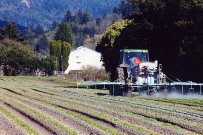Federal plant expert and Bay Area high school crew begin cutting brush to enhance rare plant habitat.

A huge Darlingtonia fen on Siskiyou Land Conservancy's Stony Creek propery. Even this large, healthy population of the carnivorous pitcher plant will eventually be threatened by encroaching shrub species. Photos by Greg King.
During the first week of March this year, Siskiyou Land Conservancy teamed up with the U.S. Fish and Wildlife Service and a team of seniors from Marin Academy High School, in San Rafael, to launch a restoration project aimed at protecting rare plants on land owned by SLC along the North Fork Smith River.
Siskiyou Land Conservancy’s 80-acre parcel is the gateway to the North Fork Smith River Botanical Area, a plant lover’s paradise. Botany enthusiasts from around the world make the pilgrimage to the North Fork to imbibe in the odd and wonderful plant worlds that thrive on the red-moon soils near the Oregon border.

Stony Creek enters the North Fork Smith River near the middle-right of this photo, where the red box illustrates the property lines of Siskiyou Land Conservancy's 80-acre parcel. The town of Gasquet is at right.
Yet most travelers on U.S. Highway 199, between Crescent City and Oregon, unwittingly slide past this international botanical treasure. If they stop at the Gasquet store, on the Middle Fork Smith River, they’re close. Moving due north just a half mile, those in the know park at the one Forest Service space reserved for a trail that enters another world, a landscape where botanists have discovered not one or two but three carnivorous plants living side by side. Also found in the region are the western bog violet and a dozen other rare plants, including the lovely McDonald’s rockcress, listed as Endangered under the federal Endangered Species Act.
The Siskiyou Land Conservancy property contains the confluence of the North Fork Smith River and its only roadless tributary, Stony Creek, where the Forest Service trail ends after a short half-mile.

Stony Creek runs through the middle of Siskiyou Land Conservancy's 80-acre parcel on the North Fork Smith River.
“The Smith River’s north fork is a country of sparse vegetation, serpentine barrens, and extensive soggy fens,” writes John Sawyer, a professor emeritus at Humboldt State University, in his seminal 2006 book, Northwest California: A Natural History. “This is the land of the Josephine ophiolite, which boasts the highest number of endemic vascular plants (70) of any outcrop of serpentine substrates on the continent. … The fens of this area are famous for the insectivorous California pitcher plant (Darlingtonia californica). … Growing with this remarkable plant is a diverse set of wet-adapted species, many associated with bog and fen conditions in Canada, including the insectivorous butterwort and sundew. … The botanically famous Stoney Creek Trail is an excellent introduction to the serpentine plants of the Josephine ophiolite.” (The creek name is alternately spelled with and without the “e,” depending on the source.)

Nick and Brett, seniors at Marin Academy High School, cut brush at Stony Creek. Note the Darlingtonia plants at left, all but engulfed by encroaching shrub species.
Sawyer is concerned about the health of the rare plants in the North Fork Smith River Botanical Area. While most of the land, including the parcel owned by Siskiyou Land Conservancy, is pristine, something is missing: fire.
Prior to European settlement, fire in the region of the North Fork-Middle Fork Smith River was a regular occurrence. Lightening fires often spread through the area, and native Tolowa Indians burned to maintain dominance of acorn-bearing oak trees. Now, said Sawyer, after a century without fire the North Fork’s rare plant communities are threatened by a “densification” of shrub species.
“What do you do about this?” Sawyer asked rhetorically. “Just leaving it alone is mismanagement.” Because the areas containing rare plants are relatively small, Sawyer recommends “reducing the number of trees and cutting the shrubs back” by hand in these regions, rather than using fire, which is less predictable.

U.S. Fish and Wildlife Service Botanist Dave Imper, an expert on the flora of the North Fork Smith River, explains the restoration plan to Marin Academy students.
Dave Imper, a botanist with the U.S. Fish and Wildlife Service, calls the Stony Creek parcel “the best jewel around” due to the diversity and numbers of rare plants that grow there. In March Imper directed SLC staff and Marin Academy students in cutting back shrub species that are engulfing rare plant habitat. The work is critical, he said, because fire has been absent for so long. He said that the carnivorous plants, which depend on year-round moisture, are particularly threatened by encroaching shrub species.

Gabe examines a healthy Port Orford cedar along Stony Creek. Siskiyou Land Conservancy's property on Stony Creek contains several acres of healthy Port Orford cedar that are unaffected by the pervasive root rot that is devastating the species.
“As these things close up [with brush] they dry up,” said Imper, “and there go the carnivores.”
Restoration work at SLC’s Stony Creek parcel will continue throughout the spring, and we’re looking for volunteers. If you’re interested call 707-498-4900 or write to siskiyouland@gmail.com.


